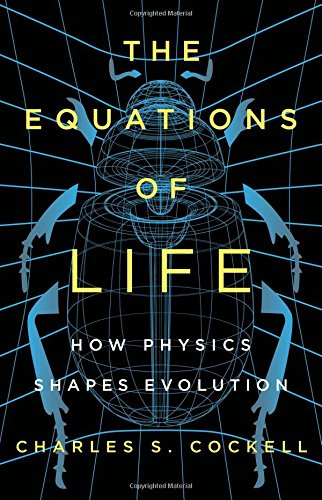![]() The Equations of Life: How Physics Shapes Evolution by Charles S. Cockell
The Equations of Life: How Physics Shapes Evolution by Charles S. Cockell
 Watch any nature show and at some point you’re sure to hear the soft-voiced narrator (usually David Attenborough or someone doing their best Attenborough impersonation) marvel at the “boundless variety” of life, of its seeming infinitude of shapes, colors, forms, and its tenaciousness in colonizing apparently every niche of our planet, no matter how harsh or isolated. Or, as theorist Ian Malcolm puts it in Jurassic Park:
Watch any nature show and at some point you’re sure to hear the soft-voiced narrator (usually David Attenborough or someone doing their best Attenborough impersonation) marvel at the “boundless variety” of life, of its seeming infinitude of shapes, colors, forms, and its tenaciousness in colonizing apparently every niche of our planet, no matter how harsh or isolated. Or, as theorist Ian Malcolm puts it in Jurassic Park:
If there is one thing the history of evolution has taught us, it’s that life will not be contained. Life breaks free, it expands to new territories and crashes through barriers, painfully, maybe even dangerously … Life finds a way.
One takes a risk in arguing with the world’s favorite fictional chaos theorist (OK, admittedly, a minor risk), but that’s just what astrobiologist Charles S. Cockell does in his new book The Equations of Life (2018), which is basically a big “Not so fast, Mr. Life-Finds-A-Way in your open shirt and tight jeans …” As he succinctly puts it in his introduction: “physical laws restrictively drive life toward particular solutions … outcomes aren’t always predicable, but they are limited.” In other words, if life often does “find a way,” it’s only while driving around a relatively restricted and tiny neighborhood sharply hemmed in by the laws of the universe.
If that sounds a bit dull, or makes one worry that Cockell is a spoilsport ruining our sense of wonder at life’s myriad expressions, Cockell closes his introduction with a reassuring promise:
The unity of evolution and physics brings a new richness to our view of life, an appreciation that within the simplicity of rules that govern and limit the forms of living things there is a remarkable beauty.
That beauty, and Cockell’s own sense of wonder at it, pops up repeatedly as he makes a methodical, clear, and highly persuasive bottom-up argument.
Cockell works through various scales as he makes his case, moving back and forth from microscopic to macroscopic as he examines, for instance, why life uses DNA to carry its code, employs electron transport to garner/harness energy, or has carbon as its base element; why water seems a requisite of life’s existence; and, more whimsically, why fish don’t have propellers and land creatures have legs rather than wheels. In each case he goes beyond simply explaining why things are as they are, exploring why possible alternatives, such as silicon-based lifeforms (with a reference to Star Trek’s Horta), are unlikely or impossible. Toward the end of The Equations of Life he closes with an exploration of what these strictures mean for the search for other life elsewhere in the solar system/universe. This last section is obviously more speculative, but it’s hard to find a flaw in his reasoning that if we do find life elsewhere, it’s much more likely to be similar in its base construction and processes than not — more likely to be carbon-based, more likely to take certain forms, more likely to need water as a base medium.
It’s all fascinating and explained in such an easy-flowing, lucid and enthusiastic style, one that leaps at times into the lyrical, that it’s easy to forget one is reading some sophisticated science. Even when Cockell refuses to shy away, as most do, from presenting the reader with the equations that give the book its title, ranging from the simple P = F/A (pressure equals force divided by area) that drives the shape of a mole’s paws, to the more complicated k=Ae (Ea/RT) (trust me, it’s more complicated), to these that Cockell uses to explain why a ladybug’s legs are a ladybug’s legs:
F = 2π γR + π γ (2cosø/h-1/R) R2 + dh/dt 3πηR4/2h3
G(ø) = sinø [4/3(l/r)2cos2 + sin2ø
NA≤9π2r8E2/64F2l6
W = F2NAlg(ø)/2πr2E
Looking at that last group (which required several minutes of hunting around for the right symbols on my keyboard) will surely make some eyes water or roll back in the head, but Cockell, even as he gives us the equations, reminds us each time that it’s not important that the reader follow the specific physics as represented by the formulae. What’s key is the understanding that despite the seeming complexity and variety of life, we can boil evolution’s choices down to some simple (despite what it looks like above) universal rules. If that seems a crude sort of reductionism, Cockell argues, “There is beauty in physical simplicity … a stunning elegance and maybe even charm in physical equations manifested in the living form.” And I can guarantee you won’t look at a ladybug or a mole, or really any other creature, the same way. Highly recommended.



Do it! One of the best things I've read in recent years.
This reminds me. I want to read Addie LaRue.
We’re in total agreement David!
I felt just the same. The prose and character work was excellent. The larger story was unsatisfying, especially compared to…
Hmmm. I think I'll pass.